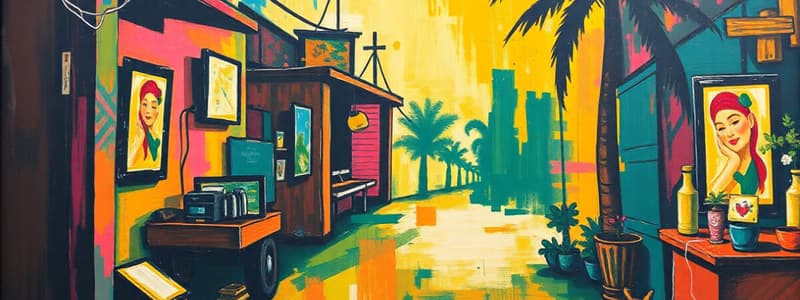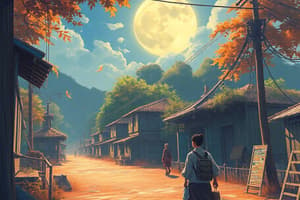Podcast
Questions and Answers
What year was the Maria Clara Awards established?
What year was the Maria Clara Awards established?
- 1960
- 1950 (correct)
- 1953
- 1945
The first 'bomba' film in the local cinema was titled 'Uhaw'.
The first 'bomba' film in the local cinema was titled 'Uhaw'.
True (A)
Name one of the teen love teams introduced during the 1960s and 1970s.
Name one of the teen love teams introduced during the 1960s and 1970s.
Nora Aunor and Tirso Cruz III
The _____ became popular during the Second Golden Age of Philippine Cinema.
The _____ became popular during the Second Golden Age of Philippine Cinema.
Match the films with their release years:
Match the films with their release years:
Which of the following themes became widespread in the 1960s?
Which of the following themes became widespread in the 1960s?
Commercial films featuring slapstick comedy were prevalent during the 1980s.
Commercial films featuring slapstick comedy were prevalent during the 1980s.
What prominent filmmaker is referred to as the 'Father of Independent Philippine Cinema'?
What prominent filmmaker is referred to as the 'Father of Independent Philippine Cinema'?
What is one notable characteristic of film production in the Philippines today?
What is one notable characteristic of film production in the Philippines today?
The resurgence of 'bomba' films occurred in the 1980s.
The resurgence of 'bomba' films occurred in the 1980s.
Name one of the strong female lead characters mentioned in the content.
Name one of the strong female lead characters mentioned in the content.
"Kung Bakit Lagi Kong Pinapanuod ang mga Pelikula ni ______" is a notable work associated with Joi Barrios.
"Kung Bakit Lagi Kong Pinapanuod ang mga Pelikula ni ______" is a notable work associated with Joi Barrios.
Which film is NOT mentioned as a popular film in the content?
Which film is NOT mentioned as a popular film in the content?
Match the films with their lead actors or actresses:
Match the films with their lead actors or actresses:
Independent films did not flourish alongside box-office films during the late 2000s.
Independent films did not flourish alongside box-office films during the late 2000s.
Why do you think popular films follow a formula in their stories?
Why do you think popular films follow a formula in their stories?
What is one of the characteristics of female protagonists often portrayed in Philippine films?
What is one of the characteristics of female protagonists often portrayed in Philippine films?
The film 'Prinsipe Amante' was the first Filipino film in full color.
The film 'Prinsipe Amante' was the first Filipino film in full color.
Name one of the Big Four production companies that dominated Philippine cinema during the 1950s.
Name one of the Big Four production companies that dominated Philippine cinema during the 1950s.
The first postwar film was directed by __________ and featured the story of Doña Aurora Quezon.
The first postwar film was directed by __________ and featured the story of Doña Aurora Quezon.
Which era is known as the First Golden Age of Philippine Cinema?
Which era is known as the First Golden Age of Philippine Cinema?
The socio-economic and political contexts of films have no impact on the storytelling of Philippine cinema.
The socio-economic and political contexts of films have no impact on the storytelling of Philippine cinema.
What visual pleasure elements are commonly depicted in bold films featuring female characters?
What visual pleasure elements are commonly depicted in bold films featuring female characters?
Match the following films or characters with their descriptions:
Match the following films or characters with their descriptions:
Flashcards
Comic adaptations in Philippine Cinema
Comic adaptations in Philippine Cinema
The trend of adapting popular comics into the film medium, characterized by eccentric costumes and film sets.
First Golden Age of Philippine Cinema
First Golden Age of Philippine Cinema
A period of great success and innovation in Philippine cinema, marked by the rise of the Big Four studios and increased film production.
Big Four of Philippine Cinema
Big Four of Philippine Cinema
The four major film studios that dominated the Philippine film industry during the 1950s.
Visual Pleasure in Philippine Film
Visual Pleasure in Philippine Film
Signup and view all the flashcards
Female Character Tropes: The Vulnerable Innocent
Female Character Tropes: The Vulnerable Innocent
Signup and view all the flashcards
Female Character Tropes: The Provocative Figure
Female Character Tropes: The Provocative Figure
Signup and view all the flashcards
Postwar Films in the Philippines
Postwar Films in the Philippines
Signup and view all the flashcards
Prinsipe Amante
Prinsipe Amante
Signup and view all the flashcards
Maria Clara Awards
Maria Clara Awards
Signup and view all the flashcards
FAMAS
FAMAS
Signup and view all the flashcards
Domestic Affairs and Infidelity in Filipino Films
Domestic Affairs and Infidelity in Filipino Films
Signup and view all the flashcards
Bomba Films
Bomba Films
Signup and view all the flashcards
Teen Love Teams
Teen Love Teams
Signup and view all the flashcards
Action Films with "Siga" Characters
Action Films with "Siga" Characters
Signup and view all the flashcards
Second Golden Age of Philippine Cinema
Second Golden Age of Philippine Cinema
Signup and view all the flashcards
Commercial Films in the 1980s
Commercial Films in the 1980s
Signup and view all the flashcards
Popular Filipino Films
Popular Filipino Films
Signup and view all the flashcards
Independent Filipino Films
Independent Filipino Films
Signup and view all the flashcards
Crossing Over of Artists
Crossing Over of Artists
Signup and view all the flashcards
Box-Office Films
Box-Office Films
Signup and view all the flashcards
Films with Strong Female Leads
Films with Strong Female Leads
Signup and view all the flashcards
Formulaic Storytelling
Formulaic Storytelling
Signup and view all the flashcards
Formula in Popular Films
Formula in Popular Films
Signup and view all the flashcards
Study Notes
Learning Outcomes
- Students will be able to describe visual pleasure in film.
- Students will be able to identify important people and circumstances that shaped popular Philippine cinema.
- Students will be able to expound on the socio-economic and political contexts of selected Philippine popular films.
- Students will be able to appreciate the potential of film as an art form and avenue for discussing societal tensions.
Pre-Assessment Instructions
- Think about a culture in your barangay/municipality (hobbies, fiestas, etc.).
- Write a 2-3 paragraph explanation of your chosen culture.
Content and Input
- Film studies analyze film as an art form, examining its technological transformation and its role in producing individual identities and cultural production.
- Visual pleasure in film, particularly female characters, is often viewed through a male gaze, where audiences experience a pleasurable looking at women, primarily through visuals, which is part of scopophilia.
- Popular Filipino films often portray female characters as sexual objects catering to the male gaze, which often involves the exploitation and objectification of women.
History of Philippine Cinema
- The cinematograph emerged in the Philippines in the late 19th century, evolving into popular silent films during the American period (1917).
- Jose Nepomuceno's Malayan Movies (1917) produced the first Filipino-produced and written film, "Dalagang Bukid."
- The 1930s saw the rise of Tagalog-language films, including "Ang Punyal na Ginto" (the first "talkie" in Philippine cinema).
- Filipino films in the 1950s, known as the first golden age, used color and adopted comic book-styled elements.
- The 1970s and 1980s saw a shift towards more dramatic and emotional themes.
- Independent films emerged in the 2000s, gaining recognition for their unique perspectives.
- Today, Philippine cinema blends local themes with international influences.
Evaluation
- The activity asks students to categorize popular and alternative films.
- The other activity requires students to write an essay about a favorite Filipino film, analyzing its characters, story, and themes.
- A synthesis activity requires students to identify Philippine popular movies resembling favored international TV series.
Studying That Suits You
Use AI to generate personalized quizzes and flashcards to suit your learning preferences.




